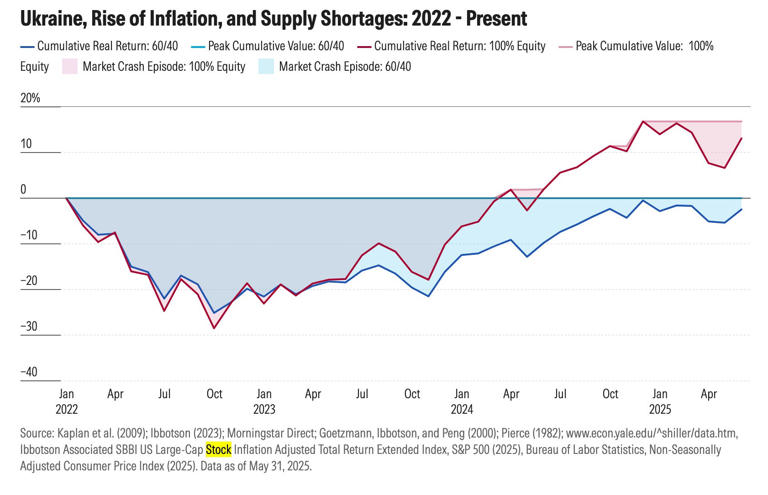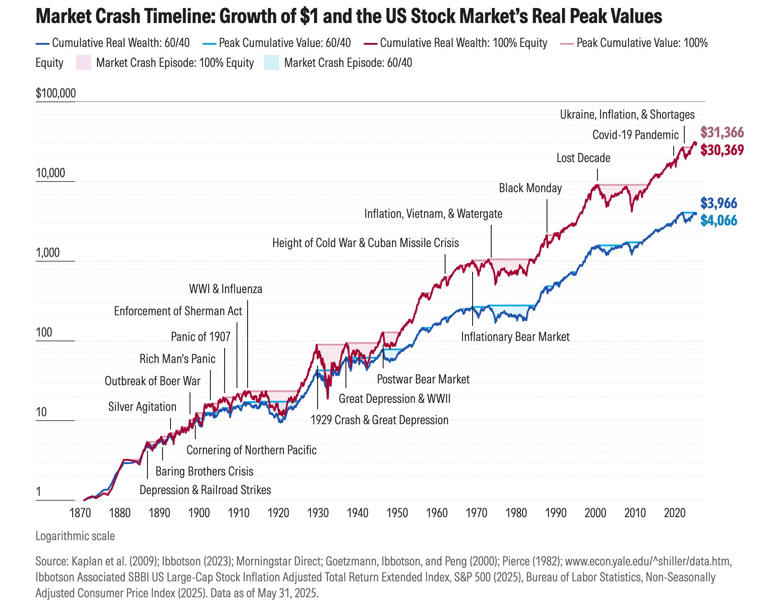Is the 60/40 Portfolio Still Alive in 2025?

According to Morningstar, the classic 60/40 portfolio of US stocks and bonds fell more than 16% in 2022—its sharpest drop since 2008. But the deeper story is that this wasn’t just a bad year. From 2021 to mid-2023, the 60/40 strategy delivered its worst stretch of underperformance in 150 years, driven largely by bond losses during a period of aggressive rate hikes and inflation. For many investors, this broke a fundamental assumption: that bonds reliably cushion equity downturns. But in a high-inflation, rising-rate environment, both asset classes sank together. So is the 60/40 portfolio dead in 2025—or just due for reinvention?
The article unpacks why the strategy may still have value, when it breaks down, and how it’s being adapted in today’s volatile market.
Key Takeaways
- The classic 60/40 mix suffered a historic drawdown in 2022 due to inflation and rate shocks.
- The strategy may still work—but only if assumptions about bonds, diversification, and risk are updated.
- Some investors are adding alternatives, international exposure, or factor tilts to adapt.
- Behavioral discipline matters more than precise allocation models.
- Tools like diversification scoring or stress-test modeling can help assess durability in today's market.
Why the 60/40 Broke Down
The 60/40 portfolio—60% equities, 40% fixed income—has long been a default for balanced investing. Historically, bonds offered income and stability during stock selloffs. That inverse relationship worked well in decades when inflation was low and rates trended downward.
World Economic Forum analysis shows the Fed’s rate hikes from March to December 2022 were the steepest in over 30 years—nearly twice the pace of the 1988–89 tightening cycle. Inflation peaked above 9% (BLS, 2022). As a result, bond prices fell sharply, alongside equity markets. The two pillars of the 60/40 both cracked.
This revealed a key vulnerability: correlation risk. When markets are hit by a macro shock—like inflation—diversification can break down. Bonds may no longer be the counterweight many assume they are.
So what happens to a model that assumes they are?
- Hypothetical: Imagine a 38-year-old investor rebalancing quarterly into a 60/40 mix through 2022. As both assets drop, the rebalancing buys into weakness—but without the usual bond support. The loss compounds, and the investor begins questioning the entire strategy.
For some, this was a wake-up call that asset allocation models need to reflect the macro regime, not just historical averages.
The chart below illustrates how both equities and bonds suffered simultaneously through 2022–2023, challenging the assumption that bonds act as reliable ballast in diversified portfolios.

It's Not Dead—Just Dated
Despite its challenges, the 60/40 portfolio isn't obsolete. But it's no longer one-size-fits-all. The real question isn't whether the strategy works, but under what conditions.
- When inflation is stable and rates are predictable, 60/40 may still offer a reasonable balance of growth and protection.
- When inflation is volatile or negative correlations break down, the mix can underperform.
Some investors are adapting with modest changes:
- Adding Treasury Inflation-Protected Securities (TIPS) to hedge real rate risk
- Including commodities or real assets for inflation exposure
- Diversifying globally to capture growth beyond the U.S.
- Using factor strategies like low volatility or value tilt
The point isn’t to throw out the framework. It’s to reexamine the assumptions that once made it work.
Despite short-term pain, the long arc of history still favors diversified strategies. The chart below shows how both 60/40 and 100% equity portfolios have delivered substantial long-term gains—even through wars, inflationary shocks, and recessions.
Still, the recent divergence highlights why investors are questioning whether past models still apply in the current macro regime.

Behavior Still Matters More Than Models
In practice, allocation discipline often matters more than allocation precision. During drawdowns, many investors panic-sell—locking in losses and derailing long-term plans. A diversified strategy like 60/40 only works if followed consistently.
That makes behavioral compatibility a feature, not a flaw. Even if 60/40 isn’t optimal on paper, it may be optimal for investors who need simplicity and consistency. Similarly, the cost of complexity—chasing tactical changes, adding too many asset classes, or timing macro trends—can often outweigh the gains.
Put differently: the best strategy is one that’s durable under pressure.
How to Stress-Test It
Some investors are now evaluating portfolios less by historical returns and more by scenario durability. In this framework, tools like:
- Diversification scoring (how uncorrelated assets actually behave)
- Historical drawdown simulations (how portfolios performed in stress years like 2008 or 2022)
- Forward-looking scenario modeling (how inflation or rate shocks affect real returns)
can help assess whether a portfolio’s mix is built to endure shocks.
Chasing the perfect allocation is a distraction. Rebalancing within an imperfect, but behaviorally sustainable, strategy is more likely to succeed long-term.
How optimized is your portfolio?
PortfolioPilot is used by over 30,000 individuals in the US & Canada to analyze their portfolios of over $30 billion1. Discover your portfolio score now:






